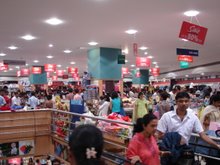Cellcos to share infrastructure, network
 Move To Facilitate Network Plans Of Vodafone & Bharti; Trai Not In Favour Of Spectrum Sharing
Move To Facilitate Network Plans Of Vodafone & Bharti; Trai Not In Favour Of Spectrum Sharing
TO EXPEDITE the rollout of mobile network across the country, the Telecom Regulatory Authority of India (Trai) has proposed that mobile service operators be allowed to share passive, active infrastructure and backhaul network. The authority has, however, not favoured sharing of spectrum, a Trai release said. Trai’s move is expected to be a shot in arm for Vodafone and Bharti, which proposed to share infrastructure. While passive infrastructure sharing, already permitted, cuts down operator’s capital and operational expenditure by about 30%, Trai’s inclusion of active infrastructure could further cut down expenses of mobile operators up to 50%. As reported first by ET, Trai while approving the infrastructure sharing, remains concerned about the complexities involved in spectrum sharing as it may disturb the levelplaying field. Trai is of the view that if spectrum sharing is allowed, ensuring quality of service and other parameters may be a difficult task and such model does not provide an easy exit path in case of disputes. Trai has noted that infrastructure is exponentially growing and entails massive investment in infrastructure, particularly passive, active and backhaul components. India would require about 3.3 lakh towers by 2010 against the present number of approximately 1 lakh towers, Trai said. The move will also help operators to expedite the network rollout and meet the government’s target of 500 million subscribers by 2010. Even if the target is achieved it will only be about 50% of the teledensity with major gaps in the rural areas. Telecom operators have welcomed the Trai’s move. COAI chairman Sanjeev Aga said, “Trai has made a number of valuable and positive recommendations that will encourage and incentivise the infrastructure sharing movement and help spread the same to all corners of the country.” DoT had sought recommendations from Trai on sharing passive infrastructure but given the significance of infrastructure sharing the authority has given the recommendation regarding active infrastructure sharing and backhaul on a suo-motu basis, Trai said. The authority has opted for cooperative efforts amongst telecom service providers with least regulatory intervention. Trai is of the view that there should be no mandated passive infrastructure sharing but the entire process should be transparent and non-discriminatory. The mode of commercial agreement has been left to the telecom service providers but Trai can prescribe a standard commercial agreement format. In other recommendation, Trai has proposed the constitution of a joint working group to take spot decisions with representatives from the telecom industry, local bodies and military. The authority has recommended for an amendment in the license conditions to allow service providers to share their backhaul from base transreceiver station (BTS) to base station controller (BSC). It has noted that such a sharing is permitted on optical fibre as well as radio medium at certain ‘nodes’. Trai has said that all licensees in any service areas should qualify for financial subvention schemes meant for rural and has also noted that non-conventional energy sources should be encouraged.
CELL CYCLE
Mobile phones communicate through electromagnetic microwaves with a cell site base station, the antennas of which are usually mounted on a tower, pole, or building
Cell sites have relatively low-power (often only one- or two-watt) radio transmitters which broadcast their presence and relay communications between the mobile handsets and the switch. The switch in turn connects the call to another subscriber
The phones have a low-power transceiver that transmits voice and data to the nearest cell sites, usually 8-13 km away. The handset constantly listens for the strongest signal being received from the surrounding base stations. As the user moves around the network, the mobile device will handoff to various cell sites during calls, or while waiting (idle) between calls it will reselect cell sites
The dialogue between the handset and the cell site is a stream of digital data that includes digitised audio (except for analog networks). Each network operator has a unique radio frequency band
Courtesy: EconomicTimes


No comments:
Post a Comment